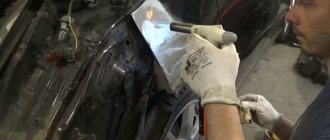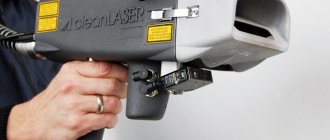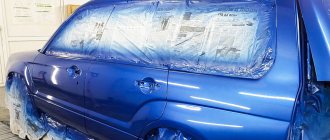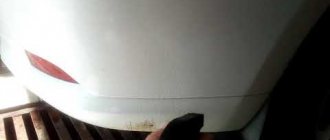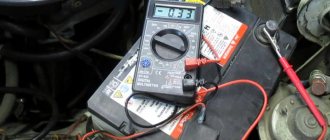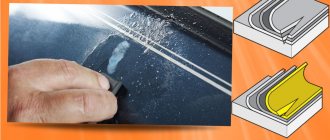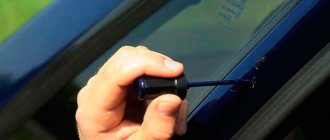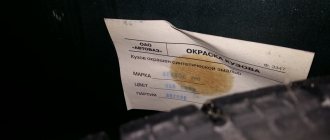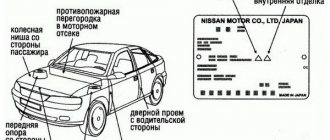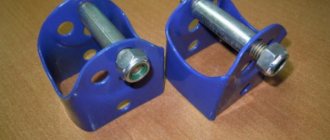When buying a used car, it is important to know whether it has been in an accident before. Often sellers, especially resellers, in order to get maximum profit, try to hide the fact of an accident with the help of cosmetic repairs. At first glance, the vehicle looks like new, but serious damage may be hidden behind its presentable appearance. In many cases, in order to reveal the deception, it is enough to check the machine with a thickness gauge.
Measuring the thickness of paintwork - why is it done?
The thickness of the paint layer on car parts is an indicator that reflects the distance from the surface of the body to the metal base itself. Paintwork can be measured in millimeters (mm), but on most modern cars it is so thin that it is measured in microns, also known as micrometers (µm). One micron is equal to 0.001 mm. Even such a small layer is enough to protect the car from water, dirt and oxygen.
This value is set at the factory depending on the vehicle model, but in accordance with accepted standards. There is no general standard and thickness can vary widely. It will depend not only on the wishes of the manufacturer, but also on the following factors:
- mode, drying temperature,
- dyeing method,
- number of layers of paint,
- brand of paint.
Why do you need to measure the thickness of paint on a car? The coating from the factory is very different from what most auto repair shops do. Perfect coloring is an expensive option, so craftsmen save on paint. A weld may be hidden under its layer if the car is a “constructor”. Putty and paint are often used to cover rot, holes, and pits in old equipment. All this is revealed by special measurements. The following data can also be checked using the meter:
- degree of wear of the machine,
- the fact that body repairs have been carried out in the past,
- presence of polished scratches,
- places where paint thickens during rough repairs,
- too frequent polishing.
Since it is almost impossible to achieve factory parameters under normal conditions, all deviations are easy to identify, which will allow you to refuse the purchase or demand a serious discount.
Are you here
What should be the factory thickness of a car's paintwork? The table helps to quickly get an answer. For most vehicles this figure is 80-170 microns. The table was compiled taking into account measurements taken on 20 thousand different types of cars.
Factory paint performance
Factory paint provides protection to the metal base of the body, as well as other layers that are applied to it - galvanization, primer. Only strict adherence to technology ensures the required durability of the body service. How much will the total thickness of the coating made at the factory be? For most cars, the indicator is in the range of 70-180 microns, while the spread across the car can be 20-25 microns, for one part - 10-15 microns. For the following elements, a layer thickness of 50-90 microns is allowed:
- door pillars,
- thresholds,
- trunk,
- engine compartment space.
It is impossible to paint a car without this error, even at the factory. The paint and varnish product may be unevenly distributed in different areas: for example, in horizontal areas the layer will inevitably be thicker than in vertical ones. Also, during painting, shagreen appears - surface roughness. Painting indicators also differ for parts made of non-ferrous and ferrous metals. Thus, even on a new car, the readings may vary when measured by the device.
How it's done
The process consists of taking measurements of the thickness of the paint layer on different parts of the car body. To do this, three main conditions must be met:
- Have a properly configured device called a thickness gauge. It will be used to take measurements.
- Be able to use it yourself or take a competent friend who knows this technique to inspect the car.
- Understand where damage to cars most often occurs during road accidents and when the owner drives carelessly. It is these places that are painted after repairs.
Determination of paint thickness by car brands
If the machine has been repaired and putty has been applied to the parts, the thickness of the coating layer will increase to 180-200 microns or more. You need to check such deviations with a special device for measuring paint - a thickness gauge. Such devices allow you to accurately measure the paint layer on products made of metal, plastic, and glass.
Modern thickness gauges do not harm the car's coating or violate its integrity. Inexpensive models help determine only the presence of putty, while higher-end products provide information about even the slightest repainting of the body. The operating principle of any thickness gauge is to calculate the interval from the sensor to the base.
Classification of thickness gauges
You can measure the thickness of paint using different instruments; there are several main ones, which differ in the method of taking measurements.
Electromagnetic thickness gauges
Such devices are only used for measuring paint on metal parts. They will not help in assessing the condition of plastic elements or non-ferrous metal products. Magnetic induction and the Hall effect are used for operation; all calculations are made based on the magnetic field density. This field is created by a soft ferromagnetic rod with a coil. The permissible percentage of error is 3%.
Eddy current thickness gauges
An electric current is generated on the surface of the probe of such a device, which passes through a coil of wound wire. As a result, an alternating magnetic field is created. When the probe is brought closer to a conductive surface (metal), Foucault currents (eddy currents) are formed, with the help of which the necessary data is obtained. Such devices are suitable for parts made of aluminum and other non-ferrous metals. The price of the devices is quite high - about 5 thousand rubles.
Capacitive thickness gauges
These measuring instruments are suitable for conductive non-magnetic products. The sensor itself serves as the first plate of the capacitor, the second will be the body. Between them there is a dielectric - a layer of paint, the capacitance of which will be measured by the device. But such thickness gauges have significant disadvantages - they are very sensitive to moisture, and their contact surface is large.
Ultrasonic thickness gauges
Such thickness gauges work with parts made of any material - metal, plastic, composites, ceramics, glass, so the user will have the opportunity to measure the layer thickness on all main and decorative parts. The probe of the devices contains an ultrasonic sensor that sends pulses through the coating. After the pulse is reflected from the surface, it is transformed into an electrical signal. The result is instantaneous - in a second the necessary numbers will be visible on the screen. The only downside is the very high price (from 10 thousand rubles).
Selection of devices
When choosing a device, it is important to understand what you plan to measure, for what purpose, and how often it will be used. If a thickness gauge is purchased by a professional, it is better to pay attention to ultrasonic models. Additional functions may be important to craftsmen - an extended temperature range, a long operating time without recharging, backlighting, the ability to connect to a computer, and load results into memory.
Those who decide to buy a device for household needs should consider less expensive options. These are electromagnetic and vortex thickness gauges. The quality of measurements will be at a decent level, the user will be able to establish the fact of repair work and the exact details of its implementation.
What else should you consider when purchasing? Here are the additional parameters of the thickness gauges:
- Battery capacity,
- launch by pressing a trigger or button,
- display size.
The most popular brands of devices are ET, CHY Firemate Company, Horstek, PHYNIX.
Plastic parts
The thickness gauge does not work on plastic parts. Modern cars have bumpers, door handles, exterior mirror housings, and sometimes other parts made of plastic. For example, the Peugeot 408 has plastic front fenders.
It is better to study the features of a specific car model before inspection. To do this, just watch 5-10 videos with an inspection of the car you need on YouTube.
A thickness gauge on a dirty car may fail or break.
It is wrong to use a thickness gauge on a dirty car. Firstly, the readings may be incorrect. Secondly, using a thickness gauge on a dirty body spoils both the device and the car’s paint.
Wash your car before checking. You need to inspect a clean car. This is useful not only for the thickness gauge, but also for finding defects. It looks better when clean.
Proper Use of a Thickness Gauge
Before starting work, you should check whether the battery is sufficiently charged (the charge level should be at least 60-70%). Otherwise, the measurement may be incorrect. The surface for measurement must be cleaned of visible dirt, grease, and other stains.
How to check paint thickness? Working with the device is very simple. It needs to be started (turned on), after activating the display, apply the sensitive element to the target area. Usually they choose a dubious one, which even outwardly seems suspicious. In other cases, you should apply the device to any point on every part of the car.
It is best to use the “square-nest” method. To do this, the body is mentally divided into squares with sides of 25-35 cm, then each square is checked in 1-2 places. The method is painstaking and will take up to 1-2 hours, but it is very reliable. If you need to act quickly, use a different method. A cross is mentally drawn on each part, then measurements are taken at its extreme points and in the center. In each place you should hold the device for a few seconds - as written in the instructions for the thickness gauge. After the data is reflected, it is reset or fixed, and a new measurement is taken.
Priority check of certain parts
Experts advise starting the inspection from the roof. It is rarely painted, since this element of the car is almost never involved in accidents. The paintwork layer here will become the standard - from it you can determine what the thickness should be in other places of the body. Factory indicators in other zones are always a little higher, as provided by the technology (but not by much).
Next, the check procedure will be as follows:
- racks,
- front and rear bumpers,
- body sills,
- doors.
It is also worth checking the interior, trunk, space under the hood, and the gas tank flap. Suspicious areas are measured several times - in the center and periphery. Differences of more than 35-55 microns are considered a defect; this is not factory painting.
Let's sum it up
If you would like to see the table, please use the data in this post. You can determine the painted areas without viewing the original information on the car. The thickness of the car's paintwork will be uneven; it is often possible to visually determine the places where painting was done.
In the automotive market, every second car went through a painting procedure after purchase. And determining this fact will allow you to knock several hundred dollars off the cost of a used car. So preparing for a body survey can really pay off.
If you do not find any signs of repair, then you can safely buy such a car and enjoy its operation. Most likely, what you have in front of you is a truly undamaged car, which is quite difficult to find today. Use the information provided and choose a car to buy based on important criteria.
Paint thickness table
There is evidence according to which deviations in the thickness of the coating layer can be quickly identified. Below is a table with information on the main car brands:
| Car make | Paint thickness, microns |
| Audi A series | 80-100 |
| Audi Q series | 110-165 |
| BMW | 90-110 |
| Cadillac Escalade, CTS | 120-150 |
| Chery | 100-120 |
| Citroen | 75-125 |
| Citroen DS4 | 205-230 |
| Daewoo | 90-120 |
| Fiat | 100-140 |
| Ford | 115-145 |
| Hyundai | 70-130 |
| Honda | 80-130 |
| KIA | 100-140 |
| Lexus | 140-150 |
| Mazda | 85-130 |
| Mercedes | 165-180 |
| Mitsubishi Lancer, Pajero | 90-125 |
| Mitsubishi L200, Outlander XL, ASX | 55-75 |
| Nissan | 80-120 |
| Nissan Almera, Teana | 130-150 |
| Opel | 110-160 |
| Peugeot | 100-20 |
| Renault | 100-140 |
| Subaru | 100-140 |
| Toyota LC200, Camry, Highlander, Auris, Vers | 110-130 |
| Toyota Avensis, Corolla, Prado, Prius, RAV4 | 80-110 |
| Volkswagen | 110-140 |
| Lada Kalina, Priora | 60-100 |
| Lada Granta, Niva | 110-140 |
| Lada Largus | 180-230 |
The condition of the paintwork is almost perfect
A used car may not have excellent surface condition. There are always small scratches and chips: on the front part, grille, hood.
There are scratches from shoes on the sills. If you do not notice such flaws. And the coating looks like a new car, most likely, it was repainted.
The size of body gaps
There can be no factory-made uneven or asymmetrical gaps in the areas where the panels connect to each other. If you see anything like this. Most likely there was physical damage to the body, which was subsequently painted over. For the same reason, the doors in the car should not stick and have a clear opening order.
Fasteners, bolts and handles
During factory assembly, not all fasteners are painted along with the body. Some of them are installed on the car after finishing the painting work. It is worth carefully inspecting the car's handles; they are often ignored during repairs. Therefore, they can reveal what defects a particular car had.
Differences in painting in a car service
No ordinary car service center can perform exactly the same type of coating as the factory one. The paint always lays down in a thicker layer than it was at first. But professionals do the job efficiently, so the paintwork has minor and completely acceptable deviations. If the layer thickness is more than 40-100 microns than required, it means that putty was used during the repair. According to the experts, a coating with a deviation of up to 55 microns can be left unchanged; it provides sufficient protection against corrosion. If the values are exceeded by more than 100 microns, the elasticity of the paintwork and resistance to vibration will be an order of magnitude lower. Over time, the paint will definitely peel off.
What can the body tell about the car?
Body metal is quite an expensive part of any car. It is very important to monitor his condition carefully.
After all, this place of the car is exposed to undesirable weather conditions: strong sun, humidity and temperature fluctuations.
Often, the entire history of a given car can be traced by the condition of the body.
A professional auto mechanic will always be able to distinguish serious body damage from minor, cosmetic repairs. Based on the condition of the body, you can determine whether the car was involved in an accident and how serious the damage was.
And also how these damages were hidden. Body repairs have their own nuances that need to be taken into account when selecting a car.
Tips and tricks
What conclusions can be drawn when obtaining data after measurements? When the thickness of the paint layer on the fenders of a car is 100, on the hood 140, and on the doors 120, there is no need to be afraid. Such deviations are quite acceptable and are often observed even on a new car. But a spread of 50-80% or more indicates that the car has been painted, which means it has been in an accident. In this case, you need to conduct a more detailed analysis at a service station, paying for diagnostics. This will help avoid serious problems and costs in the future.
Essence of the question
The same situation can happen when you start looking for an expensive model in the lower price range on the used market. A list of the best options for used cars under 400,000 rubles can help to some extent, but not in assessing the condition of the body and its coating.
A separate group of buyers can be identified as those who want a certain car due to some kind of attachment, for example, BMW. Here you will have to keep your eyes open, because crime, corrosion, and multiple repairs are possible. Examination of the paint layer can tell the future owner a lot:
- Was the car involved in the accident?
- What kind of damage did you receive in the accident?
- How were the body or coating defects eliminated?
- How much can you reduce the price of a car when bargaining?
Problems related to spars
Under the influence of loads, the side members still deform over time, especially the front one (the load from the engine and its systems) suffers. Just like the front ones, the rear ones can crack and get tired. The word “get tired” implies the initiation of a crack, which over time grows throughout the entire part. Of course, an accident can also leave a significant mark.
What does operating a car with damaged side members entail? Some parameters of the car are violated: slightly, but the position of the doors, connectors of body parts, and the position of the power plant changes. The suspension geometry also suffers. Due to all these shortcomings, the car's handling is reduced. Therefore, if the body is damaged, you need to take the car for diagnostics - this decision will be correct.
If the spar completely bursts, then the entire body structure will be completely destroyed. It is because of this that after an accident, experts look at the degree of deformation of these elements. The position in which the side members are in the car also plays an important role.
Statistics: Approximately 90% of all work associated with this part occurs on the front spar. Such damage can be resolved quickly only with a frame spar - there it is simply replaced. As for the supporting body, sometimes the spars simply cannot be replaced. Let's say it was slightly dented in an accident: such damage can be corrected using a special carolin stand. For example, on the stand there are front left and rear side members - using a convenient location, mechanics measure all the parameters necessary to correct the problem.
It happens that the side members of a car are in such a state that the only option left is replacement. Changing parts entails a significant change in the properties of the entire body. After all, the shape, material and weight are calculated by the manufacturing company - in automotive centers you have to improvise. When the main parts of the spar are in good condition, a partial replacement is performed using arc gas welding.
https://youtube.com/watch?v=-IKZ-fDRlfk
When making repairs, you must insist that the new spar is no larger in size and weight than the old one. Some people prefer to harden a new one, but one must remember that such a decision may lead to a loss of shock-absorbing properties upon impact. Constant blows will lead to more serious consequences. Do not forget that in the event of an accident, the side members are checked first, and then everything else.
A few comments
- Some deviation from the readings indicated in the table of factory values is allowed. For example, on a BMW 3, the thickness gauge showed 170 microns (and according to the standard it should be in the range of 100-165), but this does not mean that the component was repaired. Much depends on the year of manufacture, place of assembly, and whether polishing was done.
- Some motorists are frightened by some scatter of values during the measurement process. Here you need to take into account that such a spread occurs even on a car that has just left the showroom. If the fender shows 100, the hood 140, the door 120, then this is normal.
- Practice has proven that the thickness of the paintwork on domestic and Japanese cars, even according to the table, is a thin layer - about 100 microns. The European manufacturer paints with a thicker ball of paint - 150 microns.
- The internal elements of the body have a layer of 40-90 microns, because external influence on them is not provided.
- Minor dust or dirt on the surface does not particularly affect the final measurement result, but a crust of dirt will be a serious obstacle to obtaining correct results.
Minimum brake disc thickness: don't miss the moment!
